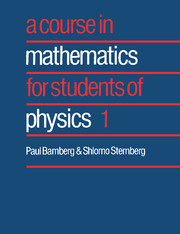Book contents
- Frontmatter
- Contents
- Contents of Volume 2
- Preface
- 1 Linear transformations of the plane
- 2 Eigenvectors and eigenvalues
- 3 Linear differential equations in the plane
- 4 Scalar products
- 5 Calculus in the plane
- 6 Theorems of the differential calculus
- 7 Differential forms and line integrals
- 8 Double integrals
- 9 Gaussian optics
- 10 Vector spaces and linear transformations
- 11 Determinants
- Further reading
- Index
9 - Gaussian optics
Published online by Cambridge University Press: 05 August 2013
- Frontmatter
- Contents
- Contents of Volume 2
- Preface
- 1 Linear transformations of the plane
- 2 Eigenvectors and eigenvalues
- 3 Linear differential equations in the plane
- 4 Scalar products
- 5 Calculus in the plane
- 6 Theorems of the differential calculus
- 7 Differential forms and line integrals
- 8 Double integrals
- 9 Gaussian optics
- 10 Vector spaces and linear transformations
- 11 Determinants
- Further reading
- Index
Summary
Chapter 9 presents an example of how the results of the first eight chapters can be applied to a physical theory – optics. It is all in the nature of applications, and can be omitted without any effect on the understanding of what follows.
Theories of optics
In the history of physics it is often the case that, when an older theory is superseded by a newer one, the older theory retains its validity, either as an approximation to the newer theory, an approximation that is valid for an interesting range of circumstances, or as a special case of the newer theory. Thus Newtonian mechanics can be regarded as an approximation to relativistic mechanics, valid when the velocities that arise are very small in comparison to the velocity of light. Similarly, Newtonian mechanics can be regarded as an approximation to quantum mechanics, valid when the bodies in question are sufficiently large. Kepler's laws of planetary motion are a special case of Newton's laws, valid for the inverse square law of force between two bodies. Kepler's laws can also be regarded as an approximation to the laws of motion derived from Newtonian mechanics when we ignore the effects of the planets on each other's motion.
- Type
- Chapter
- Information
- A Course in Mathematics for Students of Physics , pp. 311 - 339Publisher: Cambridge University PressPrint publication year: 1988

